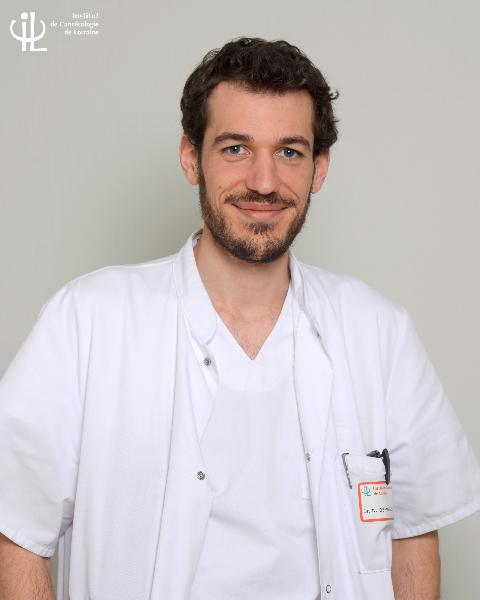CT 01 - Clinical Trials Session
LBA06 - Short-Term Androgen Deprivation Therapy and High-Dose Radiotherapy in Intermediate- and High-Risk Localized Prostate Cancer: Results from the GETUG 14 Randomized Phase III Trial
Sunday, September 29, 2024
2:10 PM - 2:20 PM ET
Location: Ballroom A/B/C

Nicolas Demogeot, MD
Institut de Cancerologie de Lorraine
Vandoeuvre Les Nancy, Meurthe-et-Mosel
Presenter(s)
N. Demogeot1, P. Sargos2, N. Sahki3, S. Guerif4, R. De Crevoisier5, G. Calais6, J. M. Hannoun-Levi7, G. Bouché8, C. Hennequin9, J. Cretin10, Y. Belkacemi11, J. Khalifa12, D. Azria13, N. Bauer14, P. Pommier15, P. Pommier16,17, J. M. Simon18, C. Léger19, V. Beckendorf3, B. M. Dubray20, and S. Supiot21; 1CLRCC Institut de Cancérologie de Lorraine, Vandoeuvre-Lès-Nancy, France, 2CRLCC Institut Bergonie, Bordeaux, Aquitaine, France, 3CRLCC Institut de Cancérologie de Lorraine, Vandoeuvre-Lès-Nancy, France, 4CHU La Milétrie, Poitiers, France, 5CRLCC Eugène Marquis, Rennes, France, 6CHRU de Tours - Centre Henry Kaplan - CORAD, Tours, France, 7CRLCC Antoine Lacassagne, Nice, France, 8CRLCC Jean Godinot, Reims, France, 9CHU Saint-Louis, Paris, France, 10Institut de Cancérologie du Gard, Nimes, France, 11Oncologie-radiothérapie GHU Henri Mondor, Université Paris Est Créteil (UPEC), Inserm – IMRB U 955 (i-Biot), Creteil, France, 12CRLCC Institut Claudius Regaud / Institut Universitaire du Cancer de Toulouse - Oncopole, Toulouse, Toulouse, France, 13Fédération Universitaire d’Oncologie Radiothérapie d’Occitanie Méditerranée, Institut du Cancer Montpellier (ICM), Univ Montpellier, INSERM U1194 ICM, Montpellier, France, 14Hôpital Emile Muller, GHRMSA, Mulhouse, France, 15Centre Leon Berard, Lyon, France, 16CRLCC Léon Bérard, Lyon, France, 17CRLCC Institut Curie, Paris, France, 18AP-HP Sorbonne Université, Charles-Foix Pitié-Salpêtrière, Paris, France, 19Unicancer, Paris, France, 20CRLCC Henri Becquerel, Rouen, France, 21Institut de Cancérologie de lOuest René Gauducheau, Saint-Herblain, France
Purpose/Objective(s): Few studies compared short-term androgen deprivation (STADT) with high-dose radiotherapy (STADT-RT) versus high-dose radiotherapy (RT) alone in localized prostate cancer. Materials/
Methods: The GETUG 14 study randomized 376 patients between RT (n=191) and STADT-RT (n=179). RT dose was 80 Gy in both arms and STADT was monthly triptorelin and daily flutamide for a total duration of 4 months, starting 2 months before irradiation. Disease-free survival (DFS) was the primary endpoint. Secondary endpoints were overall survival (OS), biochemical failure (BF), metastasis failure (MF), toxicity and quality of life.
Results: With a median follow-up of 84 months, five-year DFS was 76% in RT arm versus 84% in STADT-RT arm (hazard ratio [HR] = 0.64; [95% CI 0.43 - 0.89]; P = .02). ADT decreased BF (HR = 0.45; P = .001) and MF (HR = 0.5; P = .09) but not OS (HR = 1.22; P = .54). No difference was found in terms of gastrointestinal (26% of grade =2 in both arm, P = .97) and genito-urinary acute toxicity (39% for RT and 42% for STADT-RT, P = .55). Similarly, no difference was found in late toxicity and quality of life.
Conclusion: STADT improves disease-free survival in intermediate and high-risk prostate cancer patients receiving high dose (80 Gy) RT, without any deterioration in the safety profile.
Purpose/Objective(s): Few studies compared short-term androgen deprivation (STADT) with high-dose radiotherapy (STADT-RT) versus high-dose radiotherapy (RT) alone in localized prostate cancer. Materials/
Methods: The GETUG 14 study randomized 376 patients between RT (n=191) and STADT-RT (n=179). RT dose was 80 Gy in both arms and STADT was monthly triptorelin and daily flutamide for a total duration of 4 months, starting 2 months before irradiation. Disease-free survival (DFS) was the primary endpoint. Secondary endpoints were overall survival (OS), biochemical failure (BF), metastasis failure (MF), toxicity and quality of life.
Results: With a median follow-up of 84 months, five-year DFS was 76% in RT arm versus 84% in STADT-RT arm (hazard ratio [HR] = 0.64; [95% CI 0.43 - 0.89]; P = .02). ADT decreased BF (HR = 0.45; P = .001) and MF (HR = 0.5; P = .09) but not OS (HR = 1.22; P = .54). No difference was found in terms of gastrointestinal (26% of grade =2 in both arm, P = .97) and genito-urinary acute toxicity (39% for RT and 42% for STADT-RT, P = .55). Similarly, no difference was found in late toxicity and quality of life.
Conclusion: STADT improves disease-free survival in intermediate and high-risk prostate cancer patients receiving high dose (80 Gy) RT, without any deterioration in the safety profile.
